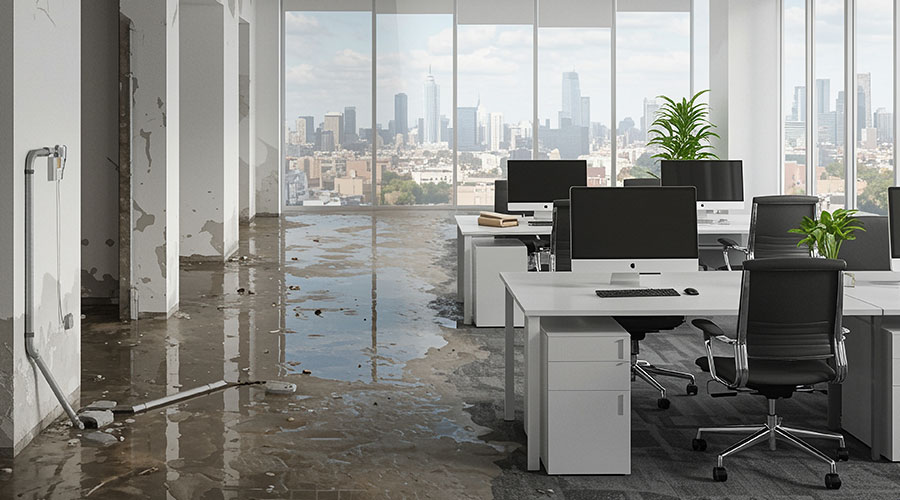 In office space in which people are frequently on the phone, one good strategy is to have workstations facing different directions so that voices aren’t traveling the same way.
In office space in which people are frequently on the phone, one good strategy is to have workstations facing different directions so that voices aren’t traveling the same way. 3 Best Practices To Get Acoustics Right
Acoustics is tricky, especially in open office environments. But with some thoughtful design strategies, your space can make occupants happier and more productive.
Whether an open office, hospital patient room, or grade-school classroom, proper sound control and acoustics are critical to happy, productive people in those spaces. But in many cases, acoustics is overlooked, not only because it’s one of the hardest facets of a space to get right, but also because of the difficulty of calculating a specific return on investment for spending money on upgrades that improve sound control. What’s more, “there are no code requirements for acoustics,” says Felicia Doggett, president and founder of Metropolitan Acoustics. “No one can force you to do this.” So in a competition for scant funds, acoustics may slide lower and lower down the priority list in favor of items like fire sprinklers that are mandated by code or energy efficiency upgrades with easily measurable results.
But as data grows about how acoustics affect people in buildings, sound control is finally becoming more of a focal point for facility managers. Acoustics is one of the leading sources of dissatisfaction with space. A study of workers in seven office buildings by the Center for the Built Environment found that 72 percent of office employees were unhappy with the level of speech privacy in their workplace. Imagine if 72 percent of occupants were unhappy with the temperature — facility managers would be either tweaking their setpoints immediately or polishing their resumes.
Improving acoustics means matching sound levels and sound control strategies to a particular space. A classroom — where speech intelligibility is paramount — may require different thinking than an open office, where the signal to noise ratio should be much higher so that conversations can blend into each other and also into the background.
To get sound control and acoustics right for any type of space, here are three areas facility managers can focus on.
1. Materials and space layout
If noise is an issue in a space, one option for facility managers is to use sound-absorbing materials and surfaces. Of course, this is always easier done in design, but retrofitting is possible. Acoustical ceiling tiles, walls and windows, furniture, and even spray-on acoustical treatments can all give overall better acoustical performance.
According to Chris Pollock, associate principal with Arup, the ceiling is actually ground zero for controlling sound in a space. “We aim for the ceiling plane to be the focal point for sound absorption,” he says. “All voices that might be bouncing around a space will eventually hit the ceiling and be absorbed.” He says the best strategy is to aim for a noise reduction coefficient in the range of .7 to .8 to give a truly high-performance acoustical ceiling.
These days, more and more products are available to help control sound. “The physics of sound absorption hasn’t changed,” says Doggett. “But manufacturers are getting more creative in how they deal with it.” She mentions new acoustical window shades and even light fixtures hitting the market.
As well, facility managers should be creative in how they lay out space, especially in open offices, says Pollock. “Not only is absorption a good thing, but layout dictates proximity of people to one another,” he says. “Consider the density of people and orientation of seating.” In spaces where people are on the phone a lot, it’s beneficial from a sound control standpoint to vary the direction people are facing so that all voices aren’t traveling in the same direction, he says. Doggett suggests using partial height barriers between workstations as well. The idea here, she says, is that blocking the line of sight and therefore also sound transmission reduces sound levels and intelligibility.
2. Soundmasking systems
Most often used in an open office environment, soundmasking systems are beneficial for helping occupants “tune out” background noise in a space. These systems, which usually include a series of speakers in or near the ceiling (but can sometimes be used under the floor, too), match the frequency of voice sound so all occupants hear less. They produce a “neutral, pleasant sound,” says Doggett.
Contrary to a space like a classroom where the signal (the teacher’s voice) should be about 15 dB above the background noise level, in an office a different signal-to-noise strategy is ideal — where the background noise and the signal are the same. “Occupants interpret this as much more comfortable,” says Pollock. “The occupant actually hears fewer voices and less noise around them.”
“I’m a big fan of soundmasking,” says Doggett. “The point is to get an even sound. You don’t want your occupants to hear all the conversations happening in a space. Soundmasking must be incorporated to do this.”
3. Combatting HVAC noise
Due to more highly efficient HVAC systems, bothersome HVAC noise is much less an issue than it was in the past. Doggett mentions that HVAC noise was a big problem in the 1970s and 1980s when engineers loved using unit ventilators in spaces. They were cheap, she says, but they put out a ton of noise into a room. Thankfully, those have gone out of fashion.
But even today, for new buildings, HVAC noise must be a key consideration in design — though Doggett says acoustics isn’t often top of mind for mechanical engineers. Pollock agrees: “It’s important to understand where the mechanical rooms are, and whether peripheral equipment dotted through a space creates pockets of sound,” he says. “These are discussions that must be had early in the process.” It’s often up to building owners to be sure acoustics is considered during design, though they can also hire an acoustical consultant to handle these questions for them.
In existing buildings, controlling annoying HVAC noise in spaces where it’s bothersome to occupants can be a little more challenging. “If you have the ability to enclose equipment creating noise, you can get it to be quieter,” says Pollock. Otherwise, moving HVAC equipment may be considered, though this may be much more costly.
Related Topics:













